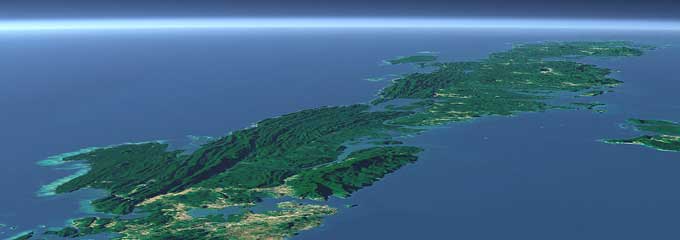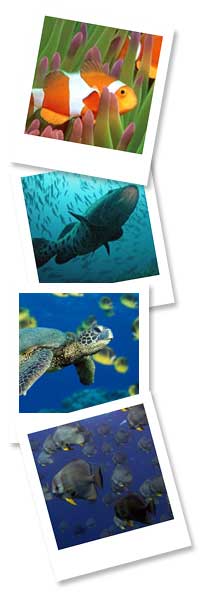
The Andaman Islands are located in the Bay of Bengal about 900km from India. The group of around 274 islands (26 of which are inhabited) makes a delicate chain stretching 755km, strung off the southern tip of Burma, and aligned north to south, to the fringes of Sumatra. The Andaman Islands is a magical place. Life here moves more slowly, untouched by commercialism and modern intrusions. Thickly covered with wild tropical jungles, the islands support a profusion of wild life including some extremely rare birds and animals you will only find in the Andamans. You値l find beautiful unspoiled beaches here, surrounded by warm tropical waters in shades of blues and greens. The seas around the Andamans are some of the worlds most unspoiled and undiscovered. Filled with pristine reefs, a kaleidoscope of colors and corals and a mind-boggling array of fish.
The climate remains tropical throughout the year, with temperatures ranging from 24 - 35 C (75 - 95 F) and humidity levels never below 70%. The best time of the year to visit is between January and may. From mid may to October heavy rains flush the islands, while November and December less severe rains arrive with the northeast monsoon. Despite being so far east the islands run on Indian time, so the sun rises as early as 4:30am in the summer and darkness falls soon after 5:00pm
The name Andaman conceivably came from Nagnamanaba, a Sanskrit word meaning "naked man" the indigenous tribes of the Andamans intrigued all that sailed by, not just by their nudity, but they had an appearance that suggested African roots rather then Asian. The alleged ferocity that surrounded the tribes keeps them virtually untouched until modern times. There are still tribal people, although numbers have been slashed dramatically, currently living in the Andamans. There contact with outsiders is limited, and the reserves are strictly off limits to foreigners. They ask to be left alone so they can continue to live in their traditional ways. There is one island, North Sentinel, which has never been colonized. It痴 inhabitants still live completely free of outside influence, just as their ancestors did thousands of years ago. (to learn more about the tribes in the Andamans we recommend the book The Land of the Naked People: Encounters with Stone Age Islanders by Madhusree Mukerjee.)
The first settlers on the Andamans arrived in 1789. Archibald Blair of the Royal Indian Navy founded a naval base on a small island adjoining South Andaman. The naval base proved to be unhealthy for the settlers and in 1796 its residence, almost 800 people, evacuated the island. In 1858 British colonists established a penal settlement on South Andaman at Port Blair. The British used the island to imprison Indian freedom fighters. Those who sought to rid India of British colonizers by violent means were sentenced to life on the Andamans. During World War II the Japanese took control of the Andamans. The British regained control in 1945. And in 1947, the British left, handing the Andamans over to the newly freed India.
The island of Havelock is about 30km north east of Port Blair, the capital city of the Andamans. The small island (55 square miles) is covered mostly in dense green jungle with beautiful white sandy beaches shaded by tall green trees, lapped with warm waters in sublime shades of blues and greens. As far as islands in the Andamans go, Havelock is one of the more developed ones, we have phone lines and electricity, (most of the time). A couple of places in the market for Internet use, but the connection are very slow. You値l find almost everything you need here, but at a slower pace. Free of all the hassles that come with a big city. The majority of the locals are Bengali, they settled here with their families after India won its independence in 1947. You値l find them to be warm and friendly people. Still living a traditional village life untouched by mass commercialism. Their main sources of income come from farming and fishing. There is definably an air of peace and serenity that comes with the island. But we may be a bit bias, this is where us at Andaman Bubbles have chose to make are home.
Getting around Havelock is fairly simple. The ferry arrives on the northern part of the island in village 1 (all locations are numbered in Havelock). Going down the northeastern side of the island are beaches 2, 3 and 5. On the southwestern side of the island is Beach 7 (a beautiful place to watch sunset) and somewhere in the middle is Village 6. Most resorts and activities are located along the northeast (1-5) or along number 7. You can walk from beach 1 to 5 in about an hour. To get to beach 7, (which is about 30 min away by bus) you値l need auto transportation. There is a few local buses that run on Havelock and. Auto rickshaws are readily available. You can also rent a motor bike (remember to get your drivers license) or bicycle.
Most of Havelock runs off of cash, with a few of the larger resorts accepting credit cards and foreign currency for a nominal fee, usually 3 %. There is an ATM in Havelock but the money changing facilities are not dependable on Havelock. There are money changing facilities and ATMs in Port Blair.
Havelock has a wide variety of activities to offer, which we at Andaman Bubbles will be happy to arrange for you. Whether you池e exploring the treasures of the sea by either scuba diving or snorkeling. Spending time deep sea fishing, hiking through the jungle, experiencing traditional village life, or enjoying the simplicity of the island. By simply laying in a hammock gazing at the wonders, lazing on the beach looking for treasures in the sand or floating in the sea. You値l leave here with memories that you値l treasure for a lifetime.





